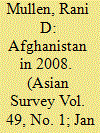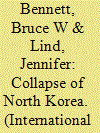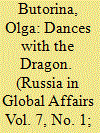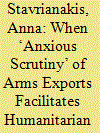|
|
|
Sort Order |
|
|
|
Items / Page
|
|
|
|
|
|
|
| Srl | Item |
| 1 |
ID:
086676


|
|
|
|
|
| Publication |
2009.
|
| Summary/Abstract |
The state-building endeavor in Afghanistan came to the brink in 2008 with the Taliban insurgency taking control of some southern districts, high poppy production fueling the illicit economy, widespread charges of corruption, and a looming humanitarian disaster. Afghans increasingly became disillusioned by high civilian casualties and the government's failure to provide improved socioeconomic conditions. By year's end, there was also increased pressure for negotiations with moderate Taliban elements.
|
|
|
|
|
|
|
|
|
|
|
|
|
|
|
|
| 2 |
ID:
079084


|
|
|
|
|
| Publication |
2007.
|
| Summary/Abstract |
Over the past decade, Burma has gone from being an antidemocratic embarrassment and humanitarian disaster to being a serious threat to its neighbors' security. The international community must change its approach to the country's junta
|
|
|
|
|
|
|
|
|
|
|
|
|
|
|
|
| 3 |
ID:
107650


|
|
|
|
|
| Publication |
2011.
|
| Summary/Abstract |
In North Korea, the upcoming leadership transition in the Kim Jong-il regime will be a precarious time for the Kim family's hold on power. A collapse of the North Korean government could have several dangerous implications for East Asia, including "loose nukes," a humanitarian disaster, a regional refugee crisis, and potential escalation to war between China and the United States. To respond to a collapse and these problems, neighboring countries may perform several military missions to stabilize North Korea. These include the location and securing of North Korean weapons of mass destruction, stability operations, border control, conventional disarmament, and combat/deterrence operations. Assuming that collapse occurs in a relatively benign manner, military missions to stabilize North Korea could require 260,000 to 400,000 troops. If collapse occurs after a war on the peninsula, or if it sparks civil war in North Korea, the number of missions-and their requirements-would grow. Because of the size and complexity of these missions, and because of the perils associated with mismanaging them, advance and combined planning is essential. Combined planning should include those actors (e.g., China, South Korea, and the United States) that could otherwise take destabilizing action to protect their own interests.
|
|
|
|
|
|
|
|
|
|
|
|
|
|
|
|
| 4 |
ID:
087864


|
|
|
|
|
| Publication |
2009.
|
| Summary/Abstract |
The current crisis is often seen as a match to the Great Depression of the 1930s. Yet there is a hope that it would not evolve into a humanitarian disaster. The standard of living in the crisis-hit countries is much higher now than 80 years ago, and they are not facing the threat of all-out unemployment or poverty. The world's GDP is not going to fall by one quarter within the next few years, and hungry people will not be marching to Washington or other capitals, while inhuman dance marathons, such as the one in Sydney Pollack's movie is likely to forever remain a screenplay.
The two crises are similar in that they both began in the United States, with financial upheavals quickly engulfing the manufacturing sector and a majority of regions of the world. The key common characteristic is the breakdown of market mechanisms. In the 1930s, it was caused by the first wave of globalization. Production technologies changed dramatically at the turn of the 20th century: there was a breakthrough in the development of transport and communications, and transnational oil companies were established and gained a firm footing. As a result, certain national and colonial economies were drawn into the world economic system. The collapse of the New York Stock Exchange on October 24, 1929 put an end to an erratic market. It turned out that market forces could not run the world economy without an active participation by the state.
|
|
|
|
|
|
|
|
|
|
|
|
|
|
|
|
| 5 |
ID:
161668


|
|
|
|
|
| Summary/Abstract |
How is it that the UK government continues to export weapons to Saudi Arabia for use in the war in Yemen, despite an explicit commitment to international humanitarian law (IHL)? And how is it that the High Court recently dismissed a case of judicial review, confirming that the government was ‘rationally entitled to conclude’ that arms exports pose no clear risk to IHL in Yemen? In what follows, I explain how a flexible interpretation of risk, reliance on secret information, and deference of the Court to the executive serve to facilitate rather than restrict arms exports. The judges’ decision provides a stamp of approval to an arms export policy that has directly contributed to the deaths of thousands of civilians in Yemen. Attention to the Saudi/Yemen case shows the political and legal manoeuvring that goes into managing the contradictions in government arms export policy.
|
|
|
|
|
|
|
|
|
|
|
|
|
|
|
|
|
|
|
|
|